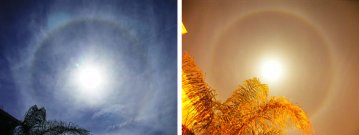 Did you sleep through the auroras? Next time get a wake-up call. Sign up for Spaceweather PHONE.
Did you sleep through the auroras? Next time get a wake-up call. Sign up for Spaceweather PHONE.
VENUS EXPRESS: For the first time in more than ten years, a spacecraft from Earth is orbiting Venus. The European Space Agency's Venus Express probe reached the 2nd planet today on a mission to study Venus's atmosphere and volcanoes: full story.
DINOSAURS ROAM THE SUN: "Solar prominence activity has been spectacular for several days now," says Mike Taormina of Palatine, Illinois. "This Brontosaurus-shaped prominence I photographed yesterday is just one example!"

Later, the seething cloud reformed itself into a gigantic gazelle, captured by Charles Tilley of Statesville, North Carolina.
The show continues today, with several lively prominences rising and falling over the sun's limb. If you have a solar telescope, take a look and see what's next in the menagerie.
more images: from Robert Arnold of the Isle of Skye, Scotland; from Andy Dodson of Huirangi, New Zealand; from Gary Palmer of Los Angeles, California; from John Stetson of Falmouth, Maine; from Monty Leventhal of Sydney Australia; from SOHO a million miles from Earth; from Liz Thompson of Exeter, Devon, UK;
STORMY HALOS: On April 7th, "the same sky that spawned dark tornados to the north delivered stunning sun halos over our Tampa skies--and moon halos nine hours later," says Florida photographer Martin Zloty. "Can you tell which is which?"

Hint: The sun halo is the one with blue sky.
These halos are caused by ice crystals floating in high cold clouds--probably cirrostratus clouds, which are often found at the advancing edge of storm fronts. Whenever you see a sun or moon halo, be alert also for icy pillars, 'dogs and other strange shapes in the sky.

